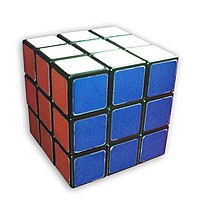Erno Rubik
Ernő Rubik (Hungarian: Rubik Ernő; Budapest, July 13, 1944) is a sculptor, architect and designer at the Budapest School of Commercial Arts, author of the Rubik's cube —although it's not the only mechanical puzzle to bear his name. Also notable are the Rubik's clock (of which he was not the inventor, he only became the owner of the patent upon purchasing it) and Rubik's Magic. His father, Ernő Rubik, was an engineer specialized in aeronautical designs, and his mother, Magdolna Szántó, graduated in literature.
Rubik's Cube
Rubik's Cube is a mechanical puzzle invented in 1974. The plastic cube comes in four different versions: a 2×2×2 (called a "Pocket Cube"); the standard, 3×3×3; that of 4×4×4 (also called "Rubik's Revenge"), and another of 5×5×5 (known as the "Professor's Cube"). Other versions of 6×6×6, 7x7x7 and 8×8×8 have also been developed. Since 2010, cubes of 9x9x9, 10x10x10, 11x11x11, 12x12x12, 13x13x13, 15x15x15 and up to 19x19x19 (mass produced) have also been marketed.
By private designer 22x22 and 33x33
Its inventor originally named it the Magic Cube. It was in May 1980, the year it was commercialized worldwide, when it was renamed Rubik's Cube. It has been said to be the world's best-selling toy, with around 350 million Rubik's cubes sold as of 2009.[citation needed]
Concept and development of the Magic Cube (Rubik's Cube)
Ernő Rubik was interested in geometry and the study of three-dimensional shapes, eager to create an artistic object but strongly tied to descriptive geometry. In those years, he also ran a Hungarian publication specializing in puzzle games. By that time, Rubik had completed his architecture studies and obtained patent HU170062 for his cube in his country, although he did not apply for any internationally. The first test batch was produced at the end of 1977 and distributed in toy stores in Budapest, his hometown.
The popularity of the cube grew in Hungary thanks to word of mouth; and although Hungary was a Warsaw Pact country, it then maintained a liberal policy of cultural exchange with its western neighbours, which rapidly spread the Cube throughout Central and Western Europe. In September 1979, Rubik reached an agreement with Ideal Toys to distribute the Rubik's Cube worldwide. Its international presentation took place at the beginning of 1980 at the Toy Fairs in London, New York, Nuremberg and Paris.
Later, Ideal Toys marketed a lighter cube, and decided to rename it. Names like Gordian Knot and Inca Gold were considered, but the company finally decided to call it Rubik's Cube, exporting it for the first time from Hungary in May 1980.
Taking advantage of the product initially being out of stock, many cheap imitations sprang up. In 1984 Ideal Toys lost a lawsuit against Larry Nichols, who had registered the product under patent US3655201. Terutoshi Ishigi registered it in Japan with the patent JP55‒8192, but even so the Hungarian Rubik's patent was the oldest and showed practically all the details of the Cube, leaving no room for doubt, thus preserving the fame of the true inventor.
Rubik has continued to live in Budapest throughout his life. He married in 1977 and has a daughter, born in 1978, and a son, born in 1981. He is introverted and has consistently refused to give interviews or sign autographs. Rubik has been excused from appearing in world championships for his famous Cube, except when he made a brief appearance at the 2007 championship, which took place in the Hungarian capital.
Rubik 360
In 2009, a new puzzle called Rubik 360, made up of different spheres, made its world premiere. The objective of this puzzle is to tilt and rotate the sphere so that it ends up with 9 cubes of the same color in the same square.
Contenido relacionado
Addendum:1 E9 s
Naval modeling
Infinitesimal

